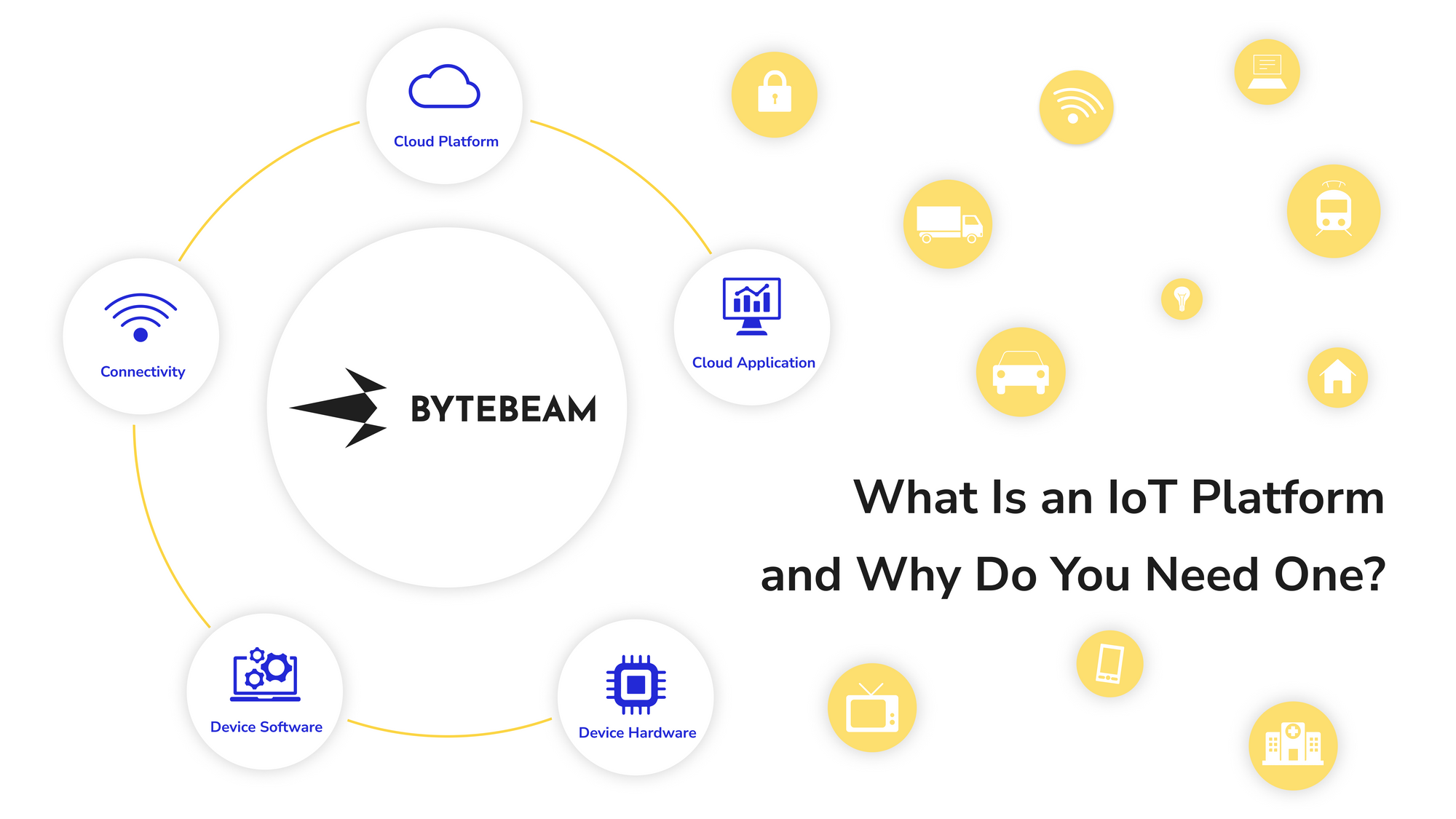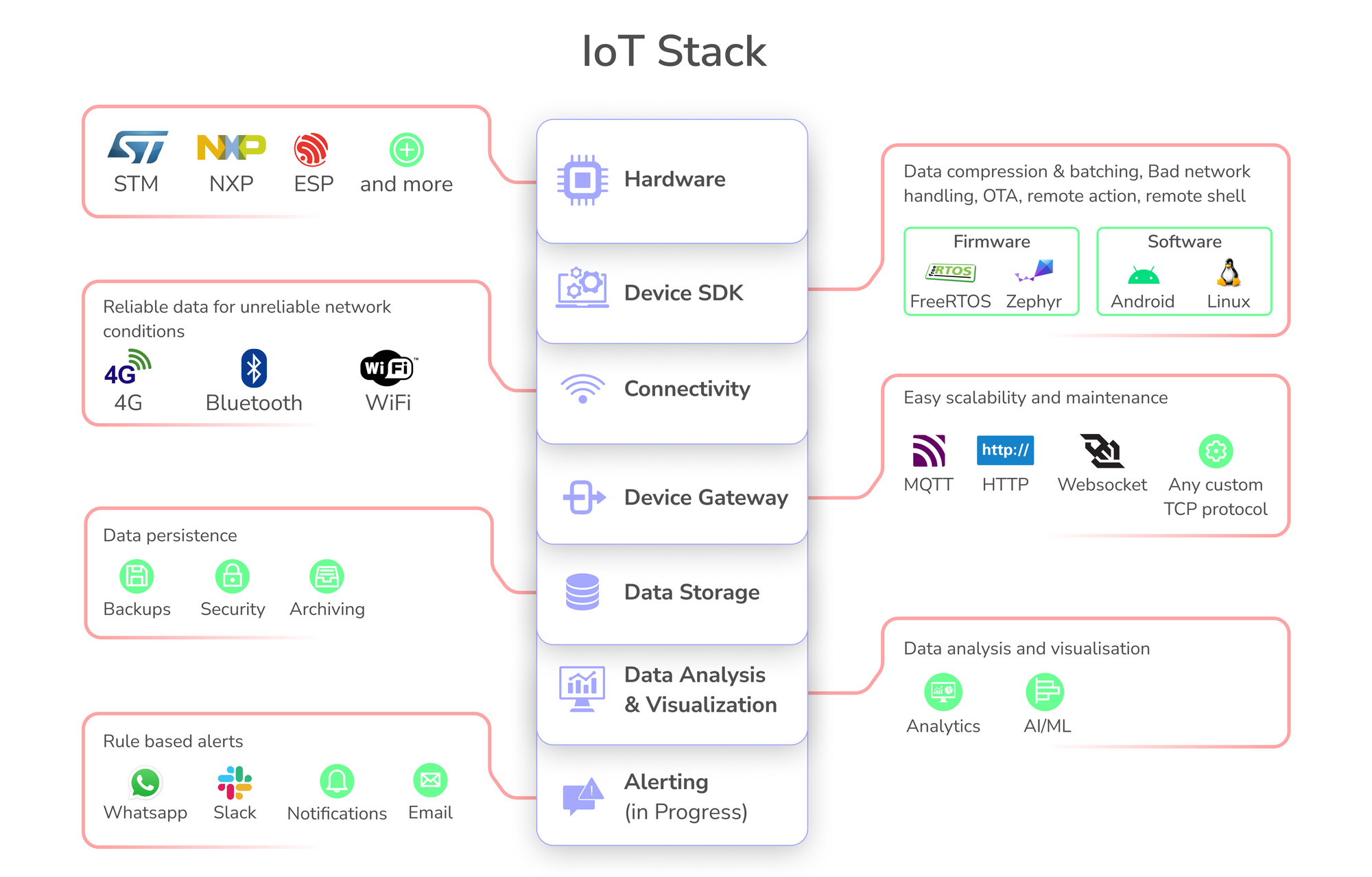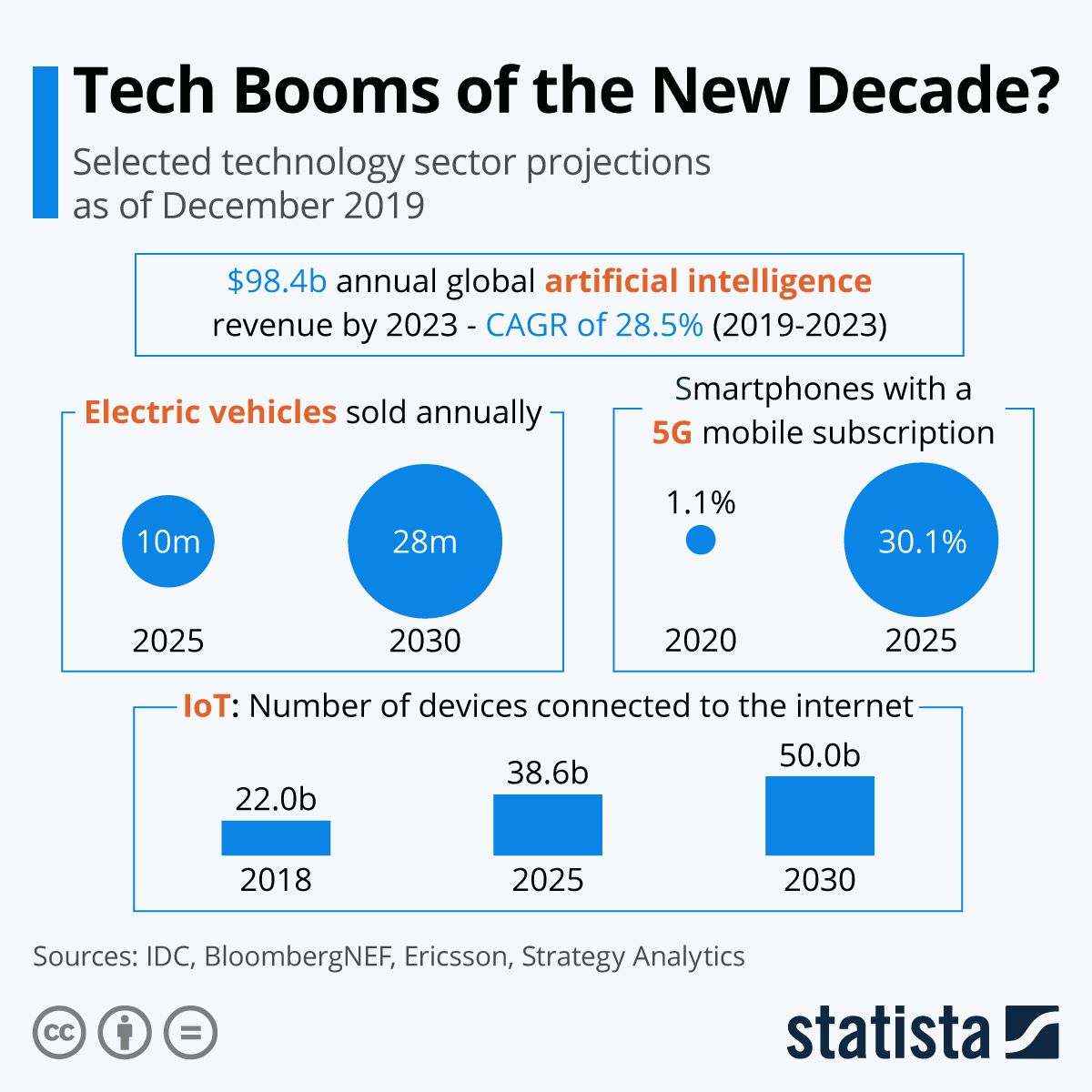What is an IoT Platform? - And How does it work?

According to a recent report, the IoT cloud platforms market is slated to grow up to USD 11.5 billion by 2025. If you're thinking about implementing an Internet of Things strategy for your company, it's important to understand what an IoT platform does and how it works. In this post, we'll explain what an IoT platform is and why you need one if you want to implement an effective IoT strategy.
What to expect: In order to completely understand IoT platforms, it is important to understand how the internet of things works. We urge you to go through our guide to get a better understanding. We have covered the basics of the components and prerequisites of an IoT platform in the following post
What is an IoT platform?
An IoT platform is a toolset that allows businesses to connect the hardware and software aspects of the technology with an easy-to-operate interface. IoT platforms have different capabilities depending on what they are built for, and they can be categorized accordingly. Different types of IoT platforms are:
- IoT cloud platform
- IoT analytics platform
- IoT connectivity platforms
- IoT device management platforms
This list is not exhaustive, and these platforms often overlap in terms of features and functionality. But before we can understand the nuances of IoT platforms, it is essential to understand IoT Architecture first. Any IoT architecture essentially has hardware, firmware, cloud backend, UI, and mobile apps, which we have further explained below.
What is an IoT architecture? and how does it work?
The IoT architecture is the range of technologies and tools used by a business for its IoT project. It is just like a regular tech stack, but is tailored to the requirements of each business or project. When you build an IoT platform, the architecture is usually what makes up the bare bones. So let’s take a look at what goes into building an IoT platform.

A basic IoT architecture involves the following factors:
Device Hardware: Devices refer to the hardware that the end user interacts with. Usually, the device hardware will have several sensors from which data is collected as well as a micro controller to process this data. Your smartwatch for example has sensors to collect heart rate and movement-related information and a microcontroller to process this data.
Firmware or Device Software: Every smart device is controlled by embedded software usually referred to as Firmware. Think of this as the brain of the device.
Connectivity: Network protocols like 5G, Bluetooth, and WiFi enable data transfer from devices to the server for storage and analysis. They also enable us to remotely interact with the device.
Cloud: Cloud platforms allow you to store the collected data for its intended use.
Application: Cloud applications are the last step in the IoT infrastructure. These applications allow you to analyze the stored data, visualize it for decision-making, and monitor the overall process from a central dashboard.
However, depending on the type of platform, or its specific uses, this architecture can look very different. Bytebeam uses a much more advanced 7-layer architecture which looks like this.

Why do you need an IoT platform?
IoT is growing rapidly; the revenue from IoT solutions is expected to hit over USD 1 trillion by 2030. The applications of IoT range from smart cities, to agriculture and healthcare, to name a few. This rapidly growing market is also generating a large amount of data every day. The number of connected devices is projected to grow by over 150% by 2030, and the number of smart homes is expected to go up by over 100%.

This survey by Statista shows us just exactly how much the IoT industry is yet to grow, and this growing industry requires backend support which comes from software. Let us understand how with a very common application of IoT.
A technology platform gives you lego blocks that you can then use to build a wider variety of applications. IoT platforms are similar. They give you the common aspects of IoT applications so that you don’t have to build them over and over again. For example, collecting & storing data is the same regardless of whether you are building an electric vehicle or a smart home appliance. Similarly, over-the-air update backend infrastructure is very similar irrespective of the end product. So essentially, an IoT platform provides a common set of tools that you can use to build a variety of applications on top.
How are IoT platforms useful?
The primary function of any IoT device platform is to take care of all the basic functionality of your product application. That way, you can focus on building the features that make your product stand out. There are several ways in which IoT platforms can prove to be useful, such as:
Enabling smart experiences: Your product features are only as good as the users deem them to be. IoT device platforms help make these features accessible to your users with a functional UI and improve user experience by making your device smarter.
Remote debugging: IoT platforms can help you debug issues remotely without having to physically monitor your devices and save time and costs at the same time.
Alerting: IoT platforms also help you keep track of your device health by sending you alerts whenever something needs your attention. This can be helpful in proactively resolving customer issues.
Data Visualization and Analytics: The data that your devices collect may be priceless, but it is raw data. IoT device platforms can help you visualize the data and make sense of it.
Remote device management: IoT hardware platforms can send over-the-air updates, monitor device health, improve device performance, and more. Remote device management can make it infinitely easier and faster to handle your devices.
Security: As with any system, yours is only as secure as your least secure device. With IoT hardware platforms, you can ensure standardized security for all your devices and data.
Cost Management: When you optimize for so many factors, your costs are bound to go down. Some IoT device platforms can even bring down your overall costs by as much as 85%.
The benefits of employing an IoT device platform can be far-ranging. But an IoT platform works for you only if you find the right fit.
How to choose an IoT platform?
Now that you know what IoT platforms are and how varied they can be, let us take a look at how to choose a platform that is right for your project. As we mentioned, there is rarely a one-size-fits-all approach to this, but some IoT platform features are universal and you can look for them before you make a decision.
Reliability
When choosing an IoT platform, reliability has to be the biggest factor worth considering. Given that you will be investing both time and capital into integrating your product with the platform, you should be able to rely on the platform. Bear in mind that reliability and popularity are not the same thing.
When looking for a reliable IoT platform, take a look at the following factors:
- Uptime
- Data security
- Align to debug in case of issues
- Feature stability
If you want to be more thorough, check for their tech stack, existing customers, testimonials, and even reach out to some of their current users if possible. If the platform works well, its users will be more than happy to let you know so.
Open APIs
Make sure that the platform you pick has open APIs so that you can extend any of the functionalities that you require. Additionally, this will also allow you to customize the platform as required.
Migration or Lock-ins
A good IoT platform does not hold you hostage. In case you need to migrate to a different platform, for any reason, the overall transfer should not be a hassle. Also, you should be able to export your data easily, if required. For example, Google recently announced that they will discontinue their IoT core service by August 2023. This has left customers with no option but to migrate to another service like AWS. In this case, smooth migration is a big help.
Device Side SDKs
A client-side SDK is essentially the set of tools on the client side that help the IoT platform collect necessary data and analyze it. A lot of complexity related to the network needs to be handled on the client side and without good client-side SDKs, you cannot build a strong product no matter how feature-rich the platform is. For example, if you are collecting data to troubleshoot issues, bad network can steamroll the entire project with data loss. Similarly, if you are doing over-the-air updates and downloads keeps failing due to a bad network, it will hamper the user experience a lot.
Expertise
One of the most common reasons to opt for a pre-built platform rather than building one is that the expertise required for it is not easily available. Therefore, you need to make sure that the team behind the platform possesses the necessary skills and expertise. This involves looking at their professional background, previous projects, and even their current capabilities. This should give you a good idea of whether they are a good fit or not.
Security
Given that IoT is a fairly new technology, IoT platforms aren’t always as secure as the rest of your systems may be. This oversight is often exploited by hackers who are on the lookout for systems to breach. IoT hacks have become so common that security must be one of your key IoT platform features to look for. Make sure that the platform follows security and data standards and does not overlook security requirements. Also, before you choose get a detailed insight into their security protocols to get a better understanding of the measures.
Essential features
This one may seem obvious, but different platforms offer different kinds of features and thus you may be trading off on some essential features when picking an IoT platform. Some of the basic IoT platform features you should look for are:
- Device Management
- Dashboarding
- Device to Mobile Communication
- Remote Shell
- Over-the-air updates
- Device Shadow
- Metadata management
- Data visualization
Scalability
Many IoT platforms are built extremely well, with a horde of features. But when it comes to going beyond a few devices, they are unable to keep up. This would be counterproductive as you want a platform that can be equally useful throughout every stage of your growth.
Onboarding
No matter how great the platform is, if you can’t use it well, it can’t be much help. Look for a business that offers a strong onboarding experience for the platform. This will also give you a peek into their support structures.
Final Thoughts
The Internet of Things is changing the world in ways that we never imagined. It’s transforming our homes, businesses, and cities, and it’s giving us new ways to interact with technology. But whether you’re just starting out with IoT or already have a lot of experience managing connected devices, it can be difficult to know where to start.
An IoT platform makes this process much easier by providing all the tools needed in one place so that you don’t have to worry about picking them out separately—and they might even improve your business by making it more efficient!
Frequently Asked Questions
What is an IoT platform?
An IoT platform is like a control center for IoT devices. It helps connect, manage, and collect data from these devices, making it easier to create and run smart applications and systems in the Internet of Things.
What are the types of IoT platforms?
There are two main types of IoT platforms:
- Device Management Platforms: These focus on connecting and managing IoT devices.
- Data Management Platforms: These handle data collection, storage, and analysis, helping turn device data into useful insights for applications.

